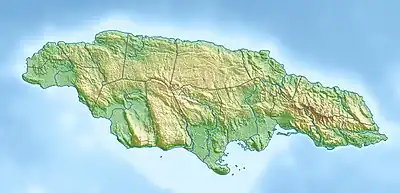John Crow Mountains
The John Crow Mountains are a range of mountains in Jamaica. They extend parallel with the northeast coast of the island, bounded to the west by the banks of the Rio Grande, and joining with the eastern end of the Blue Mountains in the southeast.[1] The highest point in the range is a little over 3,750 feet (1,140 m).[1]
| John Crow Mountains | |
|---|---|
 John Crow Mountains | |
| Highest point | |
| Elevation | 3,750 ft (1,140 m) |
| Coordinates | 18°03′13″N 76°21′17″W |
| Geography | |
| Location | Jamaica |
| Parent range | John Crow Mountains |
| Official name | Blue and John Crow Mountains |
| Type | Mixed |
| Criteria | iii, vi, x |
| Designated | 2015 (39th session) |
| Reference no. | 1356 |
| Region | Americas |
The name John Crow was first recorded in the 1820s [2] and comes from the Jamaican name for the turkey vulture. It has been suggested that previous to this, the range was known as the "Carrion Crow Ridge", after an earlier name for the vulture.[3] In 1885 Inspector Herbert T. Thomas of the local constabulary began an attempt to reach the highest peak of the range, and in 1890 was successful, publishing an account in his book 'Untrodden Jamaica'.[4] He requested the then governor Sir Henry Blake to consent that they are renamed the Blake Mountains, but admits in his book the change met with opposition. The new name did not stick and they remain the John Crow Mountains.[2]
In 1920 the explorer Scoresby Routledge claimed to have been the first person to have crossed the John Crow mountains, leading to an exchange of letters in The Times regarding Inspector Thomas's prior claim. The matter was settled by the Jamaican Surveyor-General, who decided that though Thomas had been the first to scale the highest peak, and explore the ridge in a north–south direction, Mr. Routledge had traversed the valley and further range beyond: and thus he first "actually crossed them from west to east".[5]
The John Crow Mountains are also home to the endangered Papilio homerus, the largest butterfly in the Americas. The most well-studied and understood populations of the dwindling species are found where the John Crow Mountains and the Blue Mountains meet.[6]
References
- UK Directorate of Overseas Surveys 1:50,000 map of Jamaica sheet N, 1967.
- Higman, B W; Hudson (2009). Jamaican Place Names. B J (1st ed.). Mona, Jamaica: University of the West Indies Press. pp. 89–90. ISBN 978-976-640-217-4.
- "Eager for Ecclesdown Road" at www.10000birds.com. Accessed 29 July 2011.
- Thomas, Herbert T. (1890). Untrodden Jamaica (1st ed.). Kingston, Jamaica: Aston W. Gardner & Co. Retrieved 7 February 2016.
- Baker, W. Anthony (14 September 1920). "The Times (London)". Letters to the Editor: The John Crow Mountains. No. 42515. Times Newspapers Ltd.
- Lehnert, Matthew S.; Kramer, Valerie R.; Rawlins, John E.; Verdecia, Vanessa; Daniels, Jaret C. (2017-07-10). "Jamaica's Critically Endangered Butterfly: A Review of the Biology and Conservation Status of the Homerus Swallowtail (Papilio (Pterourus) homerus Fabricius)". Insects. 8 (3): 68. doi:10.3390/insects8030068. PMC 5620688. PMID 28698508.